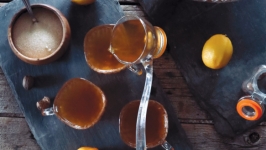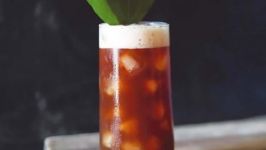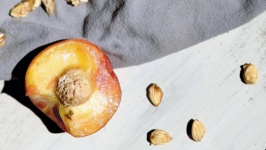Philadelphia Fish House Punch
There’s a little place just out of town, Where, if you go to lunch They’ll make you forget your mother-in-law With a drink called Fish House Punch
—The Cook magazine, 1885 (The Cook was a weekly culinary magazine published in New York)
Long before Americans wrote songs about Margaritaville and piña coladas, they were writing poems like this one about what was most likely the first famous alcoholic drink in American history, the Philadelphia Fish House Punch. This punch was invented by the Schuylkill Fishing Company of Pennsylvania (also known as the State in Schuylkill), which was founded in 1732 by an unruly group of colonial Americans who dubbed the assemblage a sovereign state. They called themselves “citizens” and even had elected officials including a governor, treasurer and sheriff. Today, nearly 300 years later, the group still meets, making it one of the oldest social clubs in the world. On their meeting days, they manage to squeeze in some outdoor activity in the form of fishing and hunting, but the main draw is the feast and their namesake punch that follows.
For many of us, the thought of an alcoholic punch probably evokes bad memories of neon-red mixtures served at college parties, but as it turns out, this class of mixed drinks can be traced back to the 1600s. Cocktail historian David Wondrich traces punch’s origins to a letter exchange between two sailors in the English East India Trade Company who learned of the concoction from Indian locals. They referred to the mix as “panch,” the Hindu word for “five,” referring to its five requisite ingredients: spirit (palm arrack, in their case), citrus, sugar, spices and a lengthener such as tea or water. The demand for punch began to spread, and it eventually supplanted the British sailors’ preferences for beer and wine for two very practical reasons. First, the higher alcohol content prevented punch from spoiling during long journeys at sea, and, more importantly, the vitamin C in the citrus helped to combat scurvy amongst sailors.
Eventually, punch’s maritime popularity spread to mainland England and subsequently their colonies, including the Americas. The drink was prepared in large batches and served out of large, elaborate China bowls at communal festivities. It became the de facto cocktail format for social gatherings of the time.
For the State in Schuylkill’s fishing days, punch preparation would begin well in advance, in a bowl so large that it was said to have doubled as a baptismal font for the citizens’ children. They would start by peeling the lemons to make the oleosaccharum. Oleo-saccharum comes from the Latin words for “oil” and “sugar” and refers to the practice of macerating citrus peels in sugar to extract their essential oils. The rest of the ingredients were then mixed in—lemon, rum, brandy, cordial, and tea—and a large block of ice was added to the bowl, along with lemon slices and freshly grated nutmeg before serving. The resulting concoction is delicious, but deceptively innocent. As an 1896 article from the Philadelphia Times states, “The mild taste of the punch is as ‘false as dicers’ oaths. . . . He who sips for the first time imagines that he has been made immortal by the ambrosia of the gods, and only realizes when he is under the table, that he still belongs to the earth.”
A few years ago, our restaurant staff learned this the hard way when we served the Fish House Punch at our company holiday party, and while we’ve since learned the dangers of the flowing bowl, no staff party is complete without the mouthwatering concoction.
To make your own, follow the recipe below, scaling it up or down depending on your party size. I recommend making this as your “dish” next time you’re invited to a potluck. As you watch the partygoers fall in love with the curious libation in the bowl, be sure to tell them the spirituous tale of America’s first famous cocktail and the colonial fishing club that invented it.









